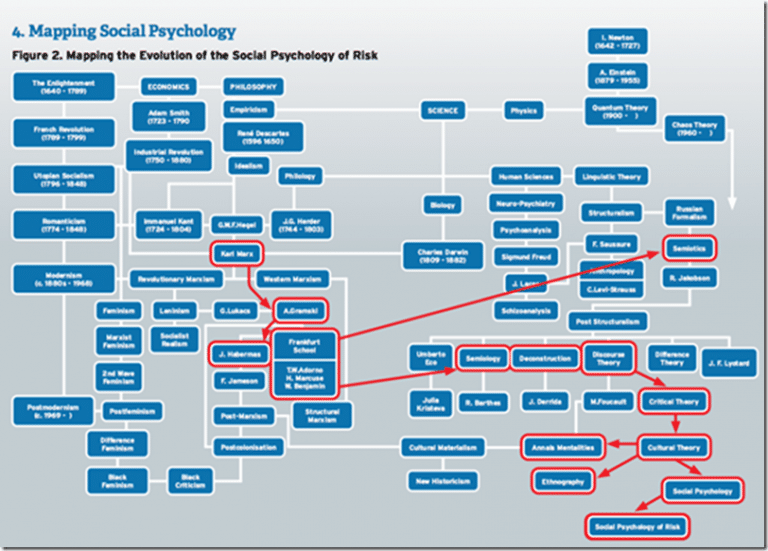Investigations and Power
In the previous blog I raised concerns about the nature of Investigations and truth telling, and the affect of culture on one’s capability to extract the truth in investigations (https://safetyrisk.net/investigations-and-truth-telling/ ). In this blog I wish to raise the important issue of power in the process of investigating.
One of the benefits of studying critical and cultural theory is a sharpened focus and consciousness about power and power in relations. Critical theory(https://en.wikipedia.org/wiki/Critical_theory) and a cultural theory of risk (https://en.wikipedia.org/wiki/Cultural_Theory_of_risk) are embedded in the evolution of the Social Psychology of Risk (SPoR) and its associated Body of Knowledge (BoK) (https://safetyrisk.net/social-psychology-of-risk-body-of-knowledge-2/ ). The evolution of the Social Psychology of Risk is illustrated below in Figure 1 Mapping the Evolution of a Social Psychology of Risk.
Figure 1. Mapping the Evolution of a Social Psychology of Risk
The SPoR BoK and Evolution of The Social Psychology of Risk are best represented graphically because semiotics is a critical aspect of SPoR thinking. When one moves away from a text-only understanding of concepts (such as in the SIA BoK), one is able to better visualize the relationships involved in a social understanding of organizing and the nature of culture in tackling risk. Understanding the complexity of social and cultural influences is not as well served by text as it is by semiotics. What is often visualized in any map of organizing is the power relations between people, organizing and social entities.
With this in mind let us reflect on the way one undertakes an investigation with a consciousness of how power affects truth telling, social engagement and the nature of evidence. The following ten tips may be helpful.
1. The investigator should be conscious of motives and possible conflict in motives. People will be able to sense unconsciously any seeking of blame in the search for cause. If one is part of zero harm language and zero harm culture then these will unconsciously shape the nature of the investigation. People will feel treated like a number.
2. Similarly, if there is any hidden agenda that mitigates against a purpose in learning, this too will nullify any possibility of truth telling.
3. The investigator should always be aware of their own power and seek to balance this in engaging with witnesses. This could include an awareness of space, place, dress and time. These critical factors can be so easily mismanaged through an eagerness to prove cause.
4. Understanding how to ask open questions and be patient are essential in putting distressed people at ease and in in building bridges to truth telling.
5. Knowing about authority and power are crucial in ensuring that a witness is not intimidated, especially an awareness of language and symbols and, how these affect perception and testimony.
6. An investigator should be aware at all times that an investigation should be an ethical process. Any power imbalance or duress will unravel in the courts and nullify the importance of a testimony. Knowledge of professional boundaries will be particularly difficult for safety people who are not trained in ethics or reflective and critical thinking. (https://safetyrisk.net/isnt-it-time-we-reformed-the-whs-curriculum/ ).
7. If one is seeking self-disclosure then an investigator ought to be trained in key elements of pastoral care (eg. reflective listening, open questioning, suspending agenda, unconditional positive regard and ‘attending’). In this respect language is critical, even a zero harm logo on a shirt will tell the witness what is the motive and focus.
8. Investigators need to understand that offering testimony can be distressing but also cathartic. Investigators should be trained in how to manage moments of intense emotions and what to do if people are distressed.
9. Investigators ought to be aware of location so that place and place do not limit truth telling. This could mean not meeting in an office, not carrying a clipboard, not carrying a camera or recording device. Other ways of recording testimony can be learned so that truth telling is enhanced.
10. Investigators need to know that all methods have their own bias, some of the most popular investigative tools on the market in risk and safety are so deficient and limited in scope it is scary. Any investigative tool that comes out of a mechanistic and deterministic philosophy will quickly alienate a witness and diminish truth telling.
If you are interested in developing a more holistic understanding of investigations then you may want to enroll as a participant in the upcoming SEEK Investigations training in Canberra on 5,6,7 July (http://cllr.com.au/product/seek-the-social-psyvhology-of-event-investigations-unit-2/).




Do you have any thoughts? Please share them below